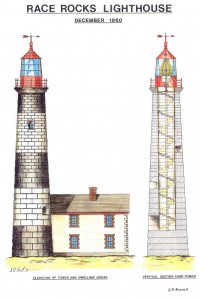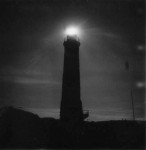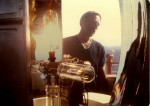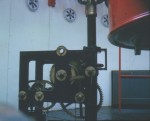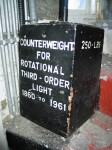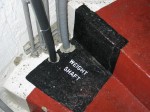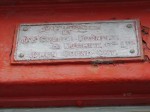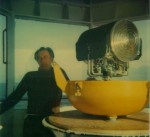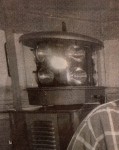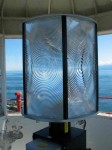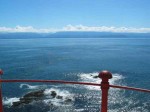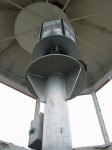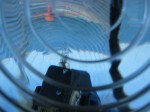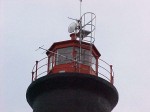Originally in 1860, the light installed at Race Rocks was made up of a tall set of crystal prisms (said to be Lalique crystal from France), designed to carry the beam from an oil or gas-light far out to sea. We do not know why this complete cage was removed but you can see in these historic photos that it was replaced with the current cage sometime in the early 1900’s. An interesting adaptation of the Fresnel lens is noted in this article about using it to focus the suns energy in photovoltaic applications:
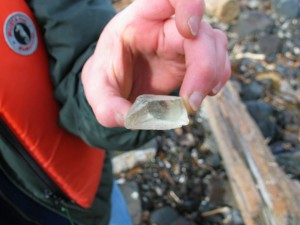 When walking over the cobble areas on the south side beaches at Race Rocks, we often turn up pieces of very thick glass. This one was found in April, 2006.This glass came from the Fresnel lens on the original light installed in 1860, seen here on the right in an artists drawing.[/caption]
When walking over the cobble areas on the south side beaches at Race Rocks, we often turn up pieces of very thick glass. This one was found in April, 2006.This glass came from the Fresnel lens on the original light installed in 1860, seen here on the right in an artists drawing.[/caption]
When walking over the cobble areas on the south side beaches at Race Rocks, we often turn up pieces of very thick glass. This one was found in April, 2006.This glass came from the Fresnel lens on the original light installed in 1860, seen here on the right in an artists drawing
In this report of John Langevin, 1872, The light is referrred to as a “second dioptric light.”The Doty burner was used in lighthouses till the end of the nineteenth century. Note this reference from the 1874 session of parliament where the expense of oil for lighthouses on the West Coast is referred to.
Trev Anderson, 2010–(When they arrived at Race Rocks) “All the equipment for the kerosene light was still there including tanks, pump, and 80mm mantles. The huge weight that was used to drive the clockworks was still connected. I believe the A/C power had just been installed at Race Rocks, as with the station at Lennard Island , and they had turned on the electricity soon after we arrived in 1962. The weight with cable was still used at Lennard Island….(it had to be rewound every two hours…good thing I was ambidextrous) !”
| From CCG reference: “These light stations used colza oil with the Argand burner until it was superseded by the introduction of mineral oils. Colza oil had been cheaper than whale oil, but mineral oil was cheaper than both and its use was extended after the development of a multiple wick burner, invented by a Frenchman, Captain Doty, for the consumption of hydro-carbon oils.” |
- Trev and Flo Anderson have supplied several of these photos of the lights in the 1970’s
- Only one bulb was illuminated at a time, the others were backups as Trev Anderson noted “they seemed to burn out rapidly.” As one light burned out, the other rotated up into position.The base of the light floated on a platform in a tub of mercury to reduce friction. “It was then changed to a four bulb auto change system with four 35mm projector bulbs, and on and on. “(TA) (We are still looking for an image of this version.)
- The gear assembly used to turn the light at Race Rocks. ( image by Trev Anderson)
- The mechanism which used to turn the light around on a bowl of mercury was this large counterweight which had to be wound up manually every four hours. There were holes in the steps which it allowed it to drop down slowly through several stories of the light tower.
- The weight still sits on a step although the holes have been concreted over with conduits running through them.. Each step in line below through over half the tower height was painted with a black square by Charles Redhead, a former lightkeeper to show the line of fall of the counterweight.
- The plaque on the Lantern room of the Race Rocks tower.
- This version with Trev Anderson, was mounted by the CoastGuard in 1968. It rotated on a fixed plate on top of the old mercury basin. The mercury was left sealed inside until an attempt to move the pedestal for a Pepsi commercial in the late 1980’s caused a spill
- We found a picture by Lawrence MacLagan of this light which was used at Race Rocks in the November 21 vol 22, 1996 issue 48 edition of Monday Magazine. Oddly enough we hadn’t been able to come up with a photograph of the light previously.It looked like a bank of a headlights around a rotating column.Only one headlight was illuminated at a time. This light was replaced with automation, in 1997.
- With automation in 1996, the light was replaced by an energy-efficient rotating lucite Fresnel lens, a modification of the type used in the 1800’s . In order to understand why the Fresnel lens is so efficient beaming light from the 100 ft height to over 20 miles at sea.**
- The view to the horizon over the railing outside the caged light.This light is visible from those far shores.
- The light stands on a pedestal. In the centre of the assembly is a 20 watt light bulb, the kind you may use in a desk lamp. This small light is visible at great distance.
- The 20 watt bulb inside the light housing.
- The beacon at the top of the tower
You can get a live close-up look of the lucite-lens light beacon above currently operating at Race Rocks by going to the remote control camera 5 .
Click on this slideshow , made on a foggy evening of July 1 2006. Images were taken from the remote camera 5.
GF Photos.

